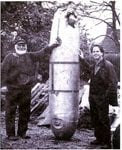ralphwiggum
Airman
- 76
- Mar 15, 2008
I'm reading the book "To Command The Sky" I was surprised to read that the U.S. fighters escorting the 8the Airforce bombers used auxiliary fuel tanks made of ----paper!  Can anyone provide me w/more info on this?
Can anyone provide me w/more info on this?
It's kinda hard for me to believe!
Thanks everybody
It's kinda hard for me to believe!
Thanks everybody


